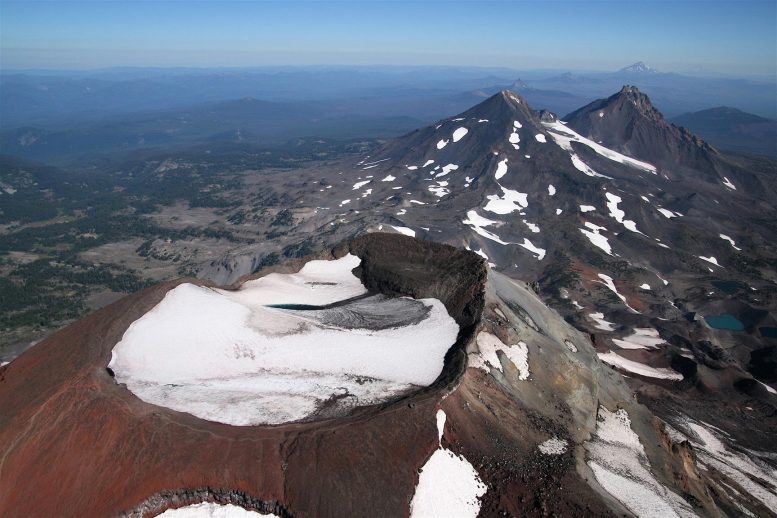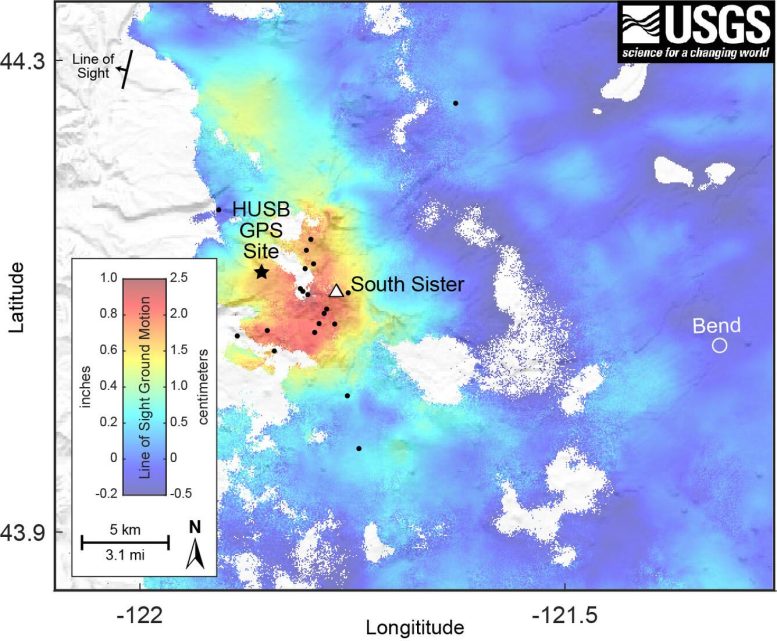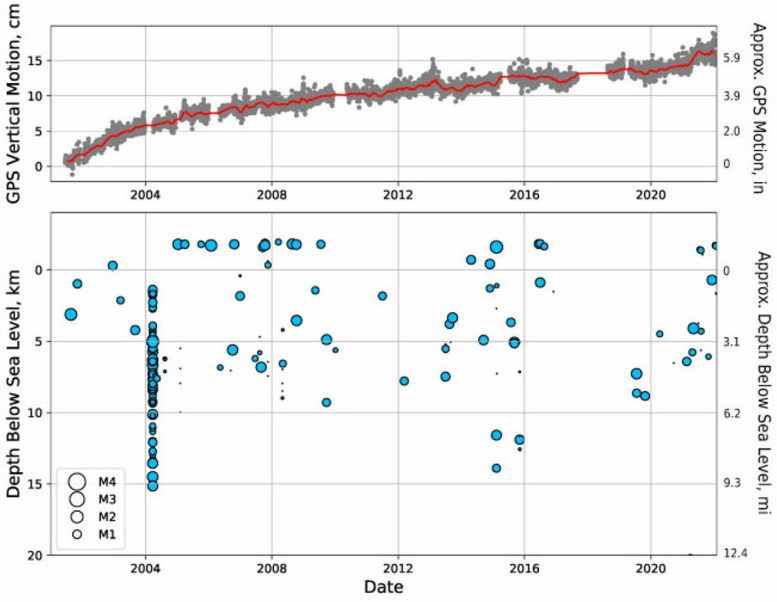GAIA IS ALIVE
Growing Ground “Bulge” Detected Near Three Sisters Volcanoes

Aerial view northward along glaciated summits of South Sister, Middle Sister, and North Sister volcanoes. Credit: Photograph by John Scurlock
Scientists detect rejuvenated uplift near South Sister volcano.
Using satellite imagery and sophisticated GPS instruments, Cascades Volcano Observatory geophysicists have detected a subtle increase in the rate of uplift of the ground surface about 3 miles (5 km) west of South Sister volcano, Oregon. Episodes of increased uplift have been observed in this area before, and the volcano’s alert level and color code remain at NORMAL / GREEN.
Data from satellite radar images show an uplift of about 0.9 inches or 2.2 cm (about the width of an adult’s thumb) occurred between the summer of 2020 and August 2021 across an area 12-mile (20-km) in diameter. GPS data from a volcano monitoring station near the center of uplift measured at least 0.2 inches (0.5 cm) of uplift since August 2021.

Satellite radar interferogram spanning June 19, 2020, to August 13, 2021, and showing the ground motion in the direction of the satellite. The maximum uplift, indicated by the red color, is about 2.2 centimeters (0.85 inches), and it is located to the west of South Sister. The HUSB continuous GPS site is marked by the large black dot. Earthquakes that occurred during the time period spanned by the interferogram are indicated by small black dots. Credit: USGS
Additionally, seismologists observed brief bursts of small earthquakes in October 2021, December 2021, and January 2022. Most of these shallow earthquakes are too small to locate precisely; those located are inside the uplifted area.
USGS geologist Dan Dzurisin is near Sisters, in Central Oregon, to set up portable GPS monitoring equipment to track something that’s been going on for 25 years and still goes on today. It’s uplift, a subtle rise in the ground’s surface, in an area west of South Sister volcano.
Uplift began in the mid-1990s and was first observed in radar satellite imagery. The USGS, working with the Forest Service, installed permanent monitoring stations to track the rate at which the area was uplifting.
In addition, every summer Dr. Dzurisin sets out GPS stations to collect ground deformation data. While radar satellites provide a picture of the entire area, these temporary GPS stations give very accurate measurements of how individual points have moved. Dr. Dzurisin and summer intern Natalea Cohen show you how they set up the semi-permanent GPS stations and talk about the importance of the work.
One thing that can cause uplift is magma moving around underground, or in particular, magma rising from greater depth in the earth up to a shallower depth, which forces the surface to move upward in a very broad area. Remarkably, this process has caused very few earthquakes. So, if you’re not using satellite radar data or some other form of data to look for it, episodes like this may have happened in other places and maybe in Central Oregon as well, and we just didn’t know it.
USGS scientists are monitoring this activity as carefully and thoroughly as they can, and will continue to monitoring the area for as long as it goes on, to gain a greater understanding of this process.
Uplift occurred in the same general region in the mid-1990s. During the 25 years between 1995 and 2020, the area rose approximately 12 inches or 30 cm (the height of a 2-liter soda bottle) at its center. Although the current uplift rate is slower than the maximum rate measured in 1999-2000, it is distinctly faster than the rate observed for several years before 2020.

Comparison of vertical GPS motion measured at station HUSB (top) with earthquake depth (bottom). Red line is a 60-day average of the cleaned GPS time series plotted in gray. Earthquakes are plotted with respect to their magnitudes. The swarm in 2004 represents the vast majority of earthquake in the vicinity of the deforming region. Earthquake information is from the Pacific Northwest Seismic Network. Credit: USGS
The uplift is attributed to small pulses of magma accumulating at roughly 4 miles (7 km) below the ground surface. While any magmatic intrusion could eventually lead to a volcanic eruption, an eruption would likely be preceded by detectable and more vigorous earthquakes, ground movement (deformation), and geochemical changes. In general, as magma moves upward during an intrusion, it causes continued or accelerated uplift, fractures rock to generate swarms of earthquakes, and releases significant amounts of volcanic gases, such as carbon dioxide. We do not detect any of these signs currently.
CVO scientists will closely monitor data in the coming months and issue further updates as warranted.
Geologists ‘closely monitoring’ rising magma under Three Sisters volcanic region
Geologist: 'Things are coming back to life now'
South Sister, Oregon (KOIN)PORTLAND, Ore. (KOIN) — The Pacific Northwest is well known for its stunning summits and plentiful peaks, but are the mountains moving?
In a USGS Hazard Notification statement Monday, Cascades Volcano Observatory announced their scientists have tracked an increased rate of ground uplift in the Three Sisters volcanic region.
Using satellite radar images and GPS units, USGS scientists have tracked an increased rate of uplift for a 12-mile diameter region, 3 miles west of the South Sister volcano. According to USGS, the data suggests the ground rose 0.9 inches (2.2 cm) from June 2020 to August 2021.
Scott Burns, a geology professor at Portland State University, told KOIN 6 News while episodes of increased uplift have been observed in this region before, the cause is what local scientists are excited about.
“The Three Sisters area is an area that we’ve been studying for the last 25 years,” Burns explained. “It’s very exciting because magma is moving up underneath the volcano … the last major volcanic eruption in Oregon, which was 2,000 years ago, was right there in that area.”
While the catalyst for the current uplift is unconfirmed, geologists have been able to credit previous soil shifts at the South Sister location to small pulses of magma accumulating approximately 4 miles below the earth’s surface.
According to Burns, increased uplift is not the only thing impacted by the observed magmatic intrusion.

“We believe that the magma is rising about four miles below the surface. And, and so associated with that, a lot of times you’ll have very small earthquakes,” Burns said. “In December and in January, we had a series of very small earthquakes, showing that there is some movement of magma. The question is, what type of magma is it going to be, and what type of volcano?”
Before the recent increase, the USGS stated the rate of uplift at the South Sister location had reportedly slowed down since scientists first recognized the phenomenon in the mid-1990s.
“From 1995 to 2020, the area rose approximately 12 inches (30 centimeters) at its center,” USGS stated in a recent release. “Although the current uplift rate is slower than the maximum rate of about 2 inches per year measured in 1999-2000, it is distinctly faster than the rate observed for several years before 2020.”
Despite the excitement, USGS and Burns have said that the public is not in any immediate danger. The volcano status is currently listed as “green,” and there is no sign of an imminent eruption.
“While any magmatic intrusion could eventually lead to a volcanic eruption, an eruption would likely be preceded by detectable and more vigorous earthquakes, ground movement (deformation), and geochemical changes,” stated USGS. “In general, as magma moves upward during an intrusion, it causes continued or accelerated uplift, fractures rock to generate swarms of earthquakes, and releases significant amounts of volcanic gases, such as carbon dioxide. We do not detect any of these signs currently.”
Burns told KOIN 6 News, a team of scientists with Cascades Volcano Observatory will continue to closely monitor uplift at the site and will be ready if a threat is detected.
“We have great maps for the whole Three Sisters area,” Burns explained, “So if it[the volcano] does come back to life, we will know which people are going to have to get out of the way and be prepared for it.”
He continued, “The good news is we’re prepared for it … We’re still at ‘green,’ but things are coming back to life now. Mother Nature writes her own history book, so it will be interesting to see what she will come up with this time.”

No comments:
Post a Comment